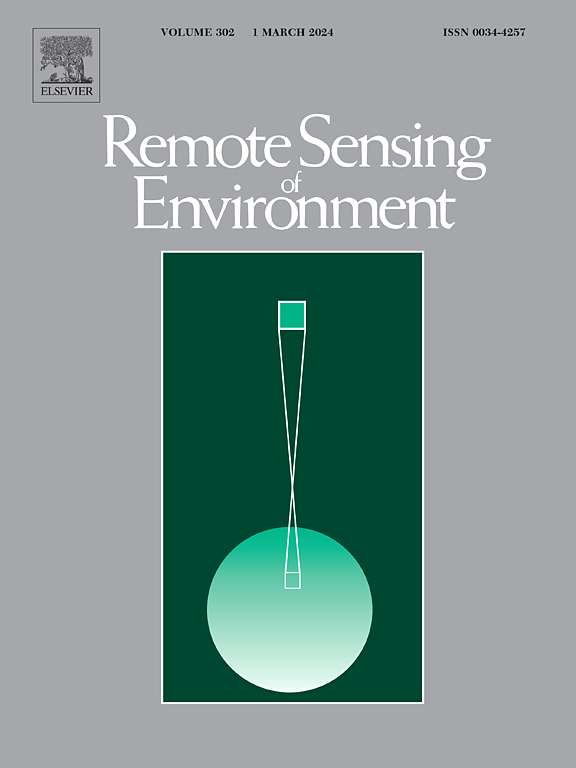中国多城市局地气候带制图及其在城市地表热岛测量中的定量应用
IF 11.4
1区 地球科学
Q1 ENVIRONMENTAL SCIENCES
引用次数: 0
摘要
局地气候带(LCZ)为城市建筑类型提供了详细的分类体系,并为块尺度的城市地表热岛(SUHI)研究提供了统一的标准。然而,仍然需要具有全球适用性的高分类精度的LCZ制图方法,以及基于LCZ的SUHI多城市比较。本研究利用多源遥感和GIS数据,结合随机森林模型,构建了中国30个城市120 m可转移的LCZ制图框架。利用Landsat 8数据、LST检索算法和空白填充法,对30个城市化水平和气候条件不同的城市中21个城市的LST进行了空白填充。研究了不同气候带和不同规模城市的SUHI强度空间格局,并利用增强回归树模型分析了城市形态对建成城市SUHI的影响。结果表明,所提出的LCZ制图框架在中国城市中具有较高的精度,总体精度在0.86 ~ 0.93之间。在美国三个城市进一步验证了其鲁棒性和可转移性,总体准确率为0.91 ~ 0.93。LST补隙法也表现良好,R值为0.71 ~ 0.91,RMSE值为1.86 ~ 3.59℃。结果表明,不同气候带城市中高层建筑(LCZ 2)和大型低层建筑(LCZ 8)的SUHI强度最高,而低层建筑(LCZ 9)和开放式低层建筑(LCZ 6)的SUHI强度最低。此外,lcz2在较冷气候区具有较高的SUHI强度,而lcz8在较暖气候区具有较高的SUHI强度。城市规模也影响建成区城市的SUHI效应,大城市的SUHI强度比小城市高1°C。此外,在建成区,植被对SUHI强度的影响相对重要性最大(20% ~ 68%),寒冷城市的影响程度高于温暖城市。不透水或建筑表面比例也占了低城市中心区SUHI贡献的13%至45%,在温暖和较大的城市中,其相对重要性约为3%至10%。本研究的结果可用于制定城市内SUHI缓解的城市规划政策,并且我们的可转移的LCZ制图框架可应用于其他全球城市的SUHI研究。本文章由计算机程序翻译,如有差异,请以英文原文为准。
Multi-city local climate zone mapping and its quantitative applications on measuring surface urban heat Island in China
Local climate zone (LCZ) provides a detailed classification system for building types in urban areas and offers a unified standard for block-scale surface urban heat island (SUHI) studies. However, LCZ mapping methods with high classification accuracy for global applicability, and multi-city comparison of SUHI based on LCZ are still needed. In this study, we developed a transferable LCZ mapping framework for 30 China cities at 120 m by using multi-source remote sensing and GIS data, and random forest model. The gap-filled LST for 21 cities among 30 cities with diverse urbanized levels and climate conditions were generated, utilizing Landsat 8 data, LST retrieval algorithm and gap-filling method. Spatial patterns of SUHI intensity across climate zones and cities of different sizes were explored, and the impacts of urban morphology on SUHI in built-up LCZs were analyzed using the boosted regression trees model. Results showed that the proposed LCZ mapping framework achieved high accuracy in China cities, with overall accuracy from 0.86 to 0.93. Its robustness and transferability were further demonstrated in three cities in the United States with overall accuracy of 0.91 to 0.93. LST gap-filling method also performed well, with R from 0.71 to 0.91 and RMSE from 1.86 °C to 3.59 °C, respectively. Our multi-city assessment revealed consistent patterns of SUHI in LCZs across climate zones: compact mid-rise (LCZ 2) and large low-rise (LCZ 8) had the highest SUHI intensity, while sparsely built (LCZ 9) and open low-rise (LCZ 6) had the lowest values. Moreover, LCZ 2 tended to have higher SUHI intensity in colder climate regions, while LCZ 8 exhibited higher values in warmer climate regions. City size also influenced SUHI effect in built-up LCZs, with large cities exhibiting SUHI intensity up to 1 °C higher than small cities. Additionally, vegetation exhibited the largest of relative importance (20 % to 68 %) which impacted SUHI intensity in built-up LCZs, with a higher value in cold cities compared to warm cities. Impervious or building surface fraction also accounted for 13 % to 45 % of the SUHI contribution across LCZs, with relative importance about 3 % to 10 % greater in warmer and larger cities. The findings of this study can be useful in developing urban planning policies for intra-city SUHI mitigation, and our transferable LCZ mapping framework can be applied to other global cities for SUHI studies.
求助全文
通过发布文献求助,成功后即可免费获取论文全文。
去求助
来源期刊

Remote Sensing of Environment
环境科学-成像科学与照相技术
CiteScore
25.10
自引率
8.90%
发文量
455
审稿时长
53 days
期刊介绍:
Remote Sensing of Environment (RSE) serves the Earth observation community by disseminating results on the theory, science, applications, and technology that contribute to advancing the field of remote sensing. With a thoroughly interdisciplinary approach, RSE encompasses terrestrial, oceanic, and atmospheric sensing.
The journal emphasizes biophysical and quantitative approaches to remote sensing at local to global scales, covering a diverse range of applications and techniques.
RSE serves as a vital platform for the exchange of knowledge and advancements in the dynamic field of remote sensing.
 求助内容:
求助内容: 应助结果提醒方式:
应助结果提醒方式:


